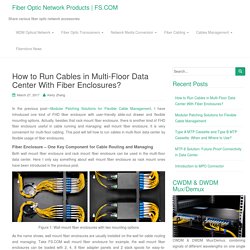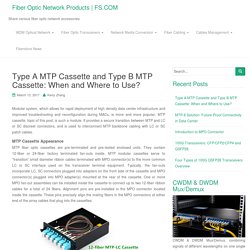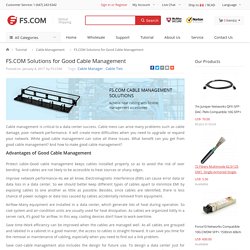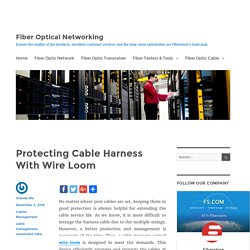

How to Run Cables in Multi-Floor Data Center With Fiber Enclosures? In the previous post—Modular Patching Solutions for Flexible Cable Management, I have introduced one kind of FHD fiber enclosure with user-friendly slide-out drawer and flexible mounting options.

Actually, besides that rack mount fiber enclosure, there is another kind of FHD fiber enclosure useful in cable running and managing: wall mount fiber enclosure. It is very convenient for multi-floor cabling. This post will tell how to run cables in multi-floor data center by flexible usage of fiber enclosures. Fiber Enclosure – One Key Component for Cable Routing and Managing Both wall mount fiber enclosure and rack mount fiber enclosure can be used in the multi-floor data center. Figure 1: Wall mount fiber enclosures with two mounting options. Type A MTP Cassette and Type B MTP Cassette: When and Where to Use? Modular system, which allows for rapid deployment of high density data center infrastructure and improved troubleshooting and reconfiguration during MACs, is more and more popular.

MTP cassette, topic of this post, is such a module. It provides a secure transition between MTP and LC or SC discreet connectors, and is used to interconnect MTP backbone cabling with LC or SC patch cables. MTP Cassette Appearance MTP fiber optic cassettes are pre-terminated and pre-tested enclosed units. They contain 12-fiber or 24-fiber factory terminated fan-outs inside. MTP Cassette Polarity: Method A or Method B The transition inside a MTP cassette, the connector keying for the MTP cassette module and the corresponding MPO array cables are completely defined for all three connectivity methods listed in the TIA standard as described in the previous post—polarity methods for MTP/MPO system.
Method A MTP Cassette vs. Connectivity Rules of Method A and Method B MTP Cassette Summary. Breakout Cabling Solution vs. Breakout Patch Panel Solution. Posted on May 26, 2016 by FS.COM Tags: 40/100 GbE , Breakout Cable , Data Center As 40/100G fiber network becomes a popular option in data centers, how to connect 40/100G devices with existing 10G devices in a cost-effective manner becomes a primary challenge for most of the data center operators.

Breakout cables and breakout patch panels are two main solutions to address this challenge. So, what's the difference between them, and which is better for your project? Continuing this tutorial, you may find more information about this. Breakout Cabling Solution Unlike 10G structures using duplex fiber (usually LC) cabling, the 40/100G or beyond 100G network uses parallel fibers (MPO/MTP) for transmission. FS.COM Solutions for Good Cable Management. Posted on January 4, 2017 by FS.COM Tags: Cable Manager , Cable Ties Cable management is critical to a data center success.

Cable mess can arise many problems such as cable damage, poor network performance. It will create more difficulties when you need to upgrade or expand your network. While good cable management can solve all these issues. Advantages of Good Cable Management Protect cable–Good cable management keeps cables installed properly so as to avoid the risk of over bending. Improve network performance–As we all know, Electromagnetic Interference (EMI) can cause error data or data loss in a data center. Airflow–Many equipment are installed in a data center, which generate lots of heat during operation. Save time–Work efficiency can be improved when the cables are managed well. Protecting Cable Harness With Wire Loom - Fiber Optical Networking. No matter where your cables are set, keeping them in good protection is always helpful for extending the cable service life.

As we know, it is more difficult to arrange the harness cable due to the multiple strings. However, a better protection and management is necessary all the time. Thus, a cable manager named wire loom is designed to meet the demands. This device efficiently arranges and protects the cables at the same time. A growing number of applications are adopting the wire looms for harness cable routing. What Is Wire Loom?
Wire loom, also known as convoluted tube, is a corrugated pipe-shaped cable organizer widely used for cable harness protection. How to Choose Wire Loom? There are three aspects that you can consider when selecting the wire loom. Benefits of Wire Loom. Tips for Fiber Optical Cable Installation. Posted on December 1, 2016 by FS.COM Tags: Cable Ties , cable installation Fiber optic cable has gained popularity among network service providers due to its high bandwidth, low power loss, light weight, low cost, etc.

Thus, fiber optic cables are widely used for today’s network cabling. Although fiber cable has so many advantages, it doesn’t mean that fiber cable installation needs no care. Attentions should also be paid when installing fiber cables at different places such as runs in the conduit, above ceilings and below floors, runs in cable trays and risers. Whenever and wherever installing fiber cable, please remember not crushing, stressing and overbending it because all fiber cables have minimum bend radius and maximum tensile loading values. Conduit Cabling It’s inflexible for conduit installation for a big difficulty to making adds, changes and moves. Note the inside radius of conduit bends should be at least 10 times the diameter of the cable. Trays Cabling Riser Cabling Conclusion.